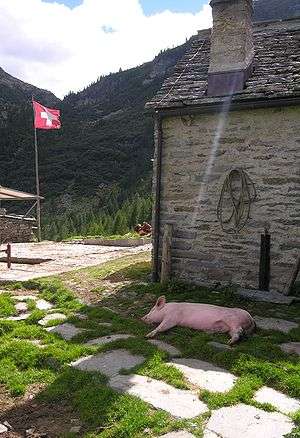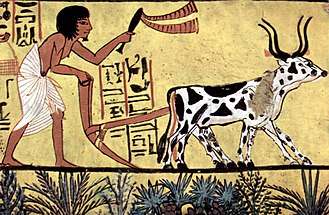Extensive farming

Extensive farming or extensive agriculture (as opposed to intensive farming) is an agricultural production system that uses small inputs of labor, fertilizers, and capital, relative to the land area being farmed.
Extensive farming most commonly refers to sheep and cattle farming in areas with low agricultural productivity, but can also refer to large-scale growing of wheat, barley, cooking oils and other grain crops in areas like the Murray-Darling Basin in Australia. Here, owing to the extreme age and poverty of the soils, yields per hectare are very low, but the flat terrain and very large farm sizes mean yields per unit of labour are high. Nomadic herding is an extreme example of extensive farming, where herders move their animals to use feed from occasional rainfalls.
Geography
Extensive farming is found in the mid-latitude sections of most continents, as well as in desert regions where water for cropping is not available. The nature of extensive farming means it requires less rainfall than intensive farming. The farm is usually large in comparison with the numbers working and money spent on it. In 1957, most parts of Western Australia had pastures so poor that only one sheep to the square mile could be supported [1]
Just as the demand has led to the basic division of cropping and pastoral activities, these areas can also be subdivided depending on the region's rainfall, vegetation type and agricultural activity within the area and the many other parentheses related to this data.
 |
| Agriculture |
|---|
| History |
| On land |
| In water |
| Related |
| Lists |
| Categories |
|
|
|
Advantages
Extensive farming has a number of advantages over intensive farming:
- Less labour per unit areas is required to farm large areas, especially since expensive alterations to land (like terracing) are completely absent.
- Mechanisation can be used more effectively over large, flat areas.
- Greater efficiency of labour means generally lower product prices.
- Animal welfare is generally improved because animals are not kept in stifling conditions.
- Lower requirements of inputs such as fertilizers.
- If animals are grazed on pastures native to the locality, there is less likely to be problems with exotic species.
- Local environment and soil are not damaged by overuse of chemicals.
- The use of machinery and scientific methods of farming produce a large quantity of crops.
Disadvantages
Extensive farming can have the following problems:[2]
- Yields tend to be much lower than with intensive farming in the short term.
- Large land requirements limit the habitat of wild species (in some cases, even very low stocking rates can be dangerous), as is the case with intensive farming.
Extensive farming may produce more methane and nitrous oxide per kg of milk than intensive farming. A 1995 study compared of a modern dairy farm in Wisconsin with one in New Zealand in which the animals grazed extensively.[3] Using total farm emissions per kg milk produced as a parameter, the researchers showed that production of methane from belching was higher in the New Zealand farm, while carbon dioxide production was higher in the Wisconsin farm. Output of nitrous oxide, a gas with an estimated global warming potential 310 times that of carbon dioxide was also higher in the New Zealand farm. Methane from manure handling was similar in the two types of farm. The explanation for the finding relates to the different diets used on these farms, being based more completely on forage (and hence more fibrous) in New Zealand and containing less concentrate than in Wisconsin. Fibrous diets promote a higher proportion of acetate in the gut of ruminant animals, resulting in a higher production of methane that must be released by belching. When cattle are given a diet containing some concentrates (such as corn and soybean meal) in addition to grass and silage, the pattern of ruminal fermentation alters from acetate to mainly propionate. As a result, methane production is reduced. Capper et al. compared the environmental impact of US dairy production in 1944 and 2007.[4] They calculated that the carbon "footprint" per billion kg (2.2 billion lb) of milk produced in 2007 was 37 percent that of equivalent milk production in 1944.
References
- ↑ Wadham, Sir Samuel; Wilson, R. Kent and Wood, Joyce (1957) Land Utilization in Australia (3rd edition), Melbourne University Press.
- ↑ Thomas, Tyrone (2000) My Environmental Exposé, Hill of Content, pp. 42–50; ISBN 0-85572-301-7
- ↑ Johnson, KA; Johnson, DE (1995). "Methane emissions from cattle". Journal of animal science. 73 (8): 2483–92. PMID 8567486.
- ↑ Capper, J. L.; Cady, R. A.; Bauman, D. E. (2009). "The environmental impact of dairy production: 1944 compared with 2007". Journal of Animal Science. 87 (6): 2160–7. doi:10.2527/jas.2009-1781. PMID 19286817.